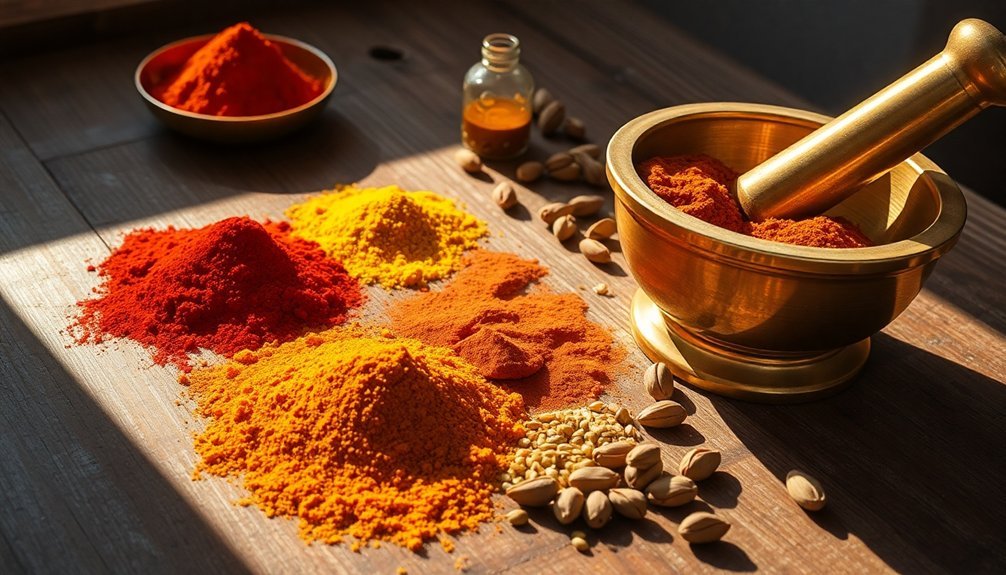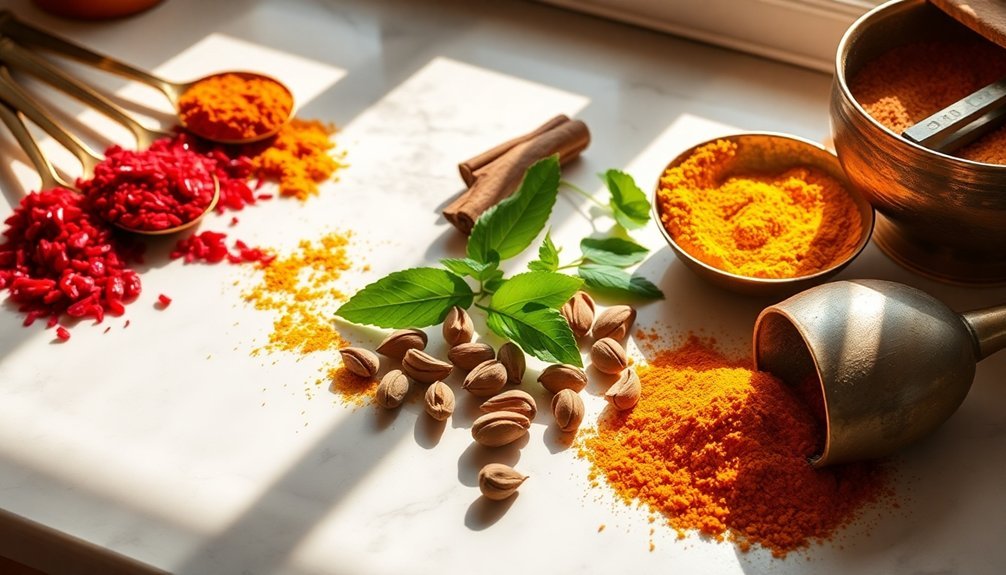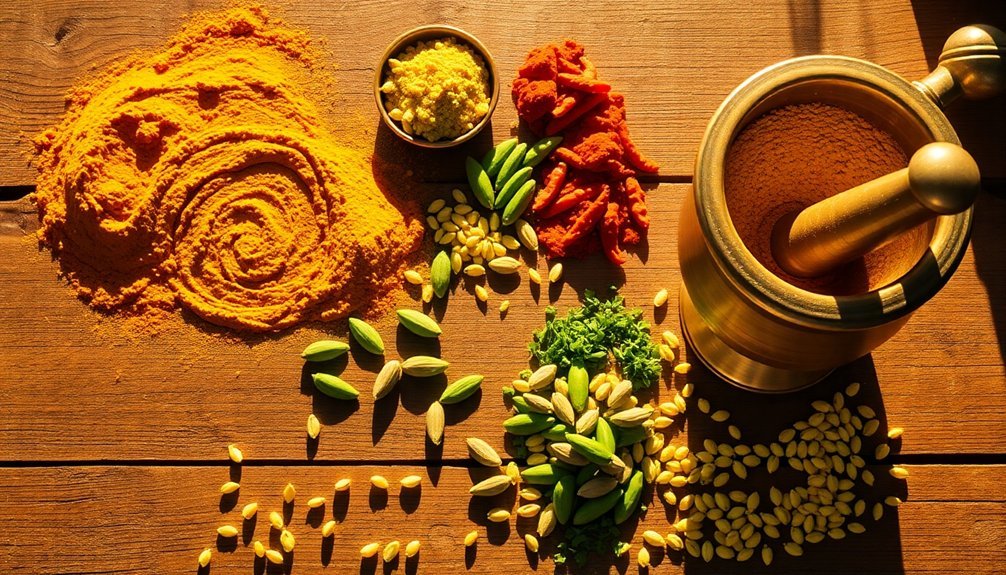Transform your Indian cooking with these sun-powered masala tips. Start by blending your base spices like cloves, peppercorns, and cardamom, roasting them individually at low heat until they puff up. Take advantage of morning sunlight to enhance your marinades, placing them in filtered light for 30-45 minutes after sunrise. Layer your spices strategically as the sun intensifies, beginning with whole spices and adding ground masalas later. Control temperatures using high smoke point oils for tempering, and position your dark cookware in sunny spots for ideal heat absorption. Discover how these traditional techniques can elevate your sustainable culinary journey.
Spice Blending for Solar Heat

When crafting the perfect Indian masala for solar cooking, you'll need to master the art of spice blending to achieve ideal results. Start with essential spices like cloves, peppercorns, cinnamon, cumin, and cardamom as your base. You can adjust these proportions based on your taste preferences and the specific dish you're preparing. Traditional households store their unique blends in a special Masala Dani for daily use. For the best flavor development, roast each spice individually on low heat until they puff slightly, then let them cool before grinding. You'll want to aim for solar oven temperatures between 225-250°F to properly develop the spices' flavors. Consider preparing your spice blends in advance to streamline your cooking process. Don't hesitate to experiment with additional spices like coriander seeds, mace, or fennel to create your signature blend that works perfectly with solar cooking methods.
Marinate With Morning Sunlight
Although morning sunlight plays an essential role in our health, it's equally important for marinating Indian masalas. When you expose your marinating spice mixtures to morning sunlight, you're tapping into nature's perfect timing for flavor development, much like your body's circadian rhythm response to early rays.
You'll find that morning sun-marinated masalas develop deeper, more complex flavors without the harsh heat of afternoon exposure. This gentle warming process mirrors how your body produces vitamin D and regulates hormones during morning sun exposure. For optimal results, try to start this process within two hours of sunrise, when the sun's rays are most beneficial for both you and your spices.
Just as sunlight helps balance your body's melatonin and serotonin levels, it helps balance your masala's aromatic compounds. Place your covered marinade container in filtered morning light for 30-45 minutes, allowing the spices to bloom gradually while preserving their delicate essential oils.
Layering Masalas While Sun Cooking

Since masalas thrive on thoughtful layering, sun cooking offers a unique opportunity to build complex flavor profiles gradually.
You'll want to start by adding your whole spices early in the day when the sun's intensity is building. This allows their subtle flavors to infuse slowly into your dish.
As the sun climbs higher, introduce your ground masalas mixed with aromatics like onions and garlic. The gentle heat will help release their essential oils without burning them. Traditional mortar and pestle grinding of these spices helps extract maximum flavor during the slow cooking process.
You can adjust the layering process by adding more robust spices during peak sun hours, when temperatures are highest. Remember to taste and fine-tune your seasonings throughout the cooking process.
Different spices release their flavors at varying temperatures, so you'll need to monitor how they develop in the solar cooker.
Temperature Control Through Spicing
Moving from the gentle warmth of sun cooking, mastering temperature control through spice selection opens up a new dimension of Indian cooking.
You'll need to carefully manage heat levels when tempering spices to extract their full potential while preventing unwanted bitterness from burning. Using one to two tablespoons of oil is ideal for proper tempering results.
Start with a high smoke point oil heated until it shimmers, then adjust your heat levels based on your spice sequence:
- Begin with whole spices like mustard and cumin seeds at medium-high heat until they pop
- Lower the heat when adding aromatics like cardamom and cinnamon
- Reduce to low or turn off completely when incorporating ground spices like turmeric
Solar-Friendly Seasoning Times

When harnessing the sun's power for seasoning, timing plays a crucial role in developing rich flavors and aromas. You'll want to start early in the morning, placing your spices in a sunny spot where they'll receive maximum exposure throughout the day.
Position your spices on a clean, flat surface and adjust their placement every few hours to follow the sun's path. You can use this time efficiently by setting up your solar oven alongside your drying spices. Dark cookware will help absorb more sunlight, enhancing both the cooking and seasoning processes.
Monitor your spices carefully – they'll typically need several hours to dry properly. Don't let them over-dry, as this can diminish their flavor.
Once they're ready, cool them separately before grinding with a mortar and pestle or spice grinder.
Frequently Asked Questions
Can Traditional Clay Pots Be Used Safely in Solar Cookers?
Yes, you can safely use traditional clay pots in solar cookers if they're unglazed, free from harmful metals, and properly handled. Just guarantee they're from a reliable source and avoid sudden temperature changes to prevent cracking.
How Does Altitude Affect Spice Measurements in Solar Cooking?
At higher altitudes, you'll need to reduce your spice measurements slightly since faster cooking times and increased solar intensity can concentrate flavors more quickly. Start with 25% less and adjust to taste.
Which Masalas Lose Potency Fastest When Exposed to Direct Sunlight?
You'll find ground masalas like cumin, coriander, and turmeric lose potency fastest in sunlight. Their increased surface area makes them more vulnerable to light damage, quickly degrading their essential oils and flavors.
Do Metal Spice Containers Affect Solar Cooking Temperatures?
No, you don't need to worry about metal spice containers affecting your solar cooker's temperature. They won't considerably impact heat levels since the cooker's performance depends more on insulation, sunlight intensity, and proper pot materials.
Should Spice Quantities Change When Cooking During Different Moon Phases?
You'll want to adjust your spice quantities across moon phases. Use more warming spices during waxing moon, peak amounts at full moon, and reduce to lighter, cleansing spices during waning moon phases.
In Summary
Now you're equipped to harness both solar power and Indian spices for flavorful, sustainable cooking. By timing your marinades with the morning sun, layering your masalas strategically, and adjusting spice levels to match solar temperatures, you'll create vibrant dishes that honor traditional Indian flavors while using clean energy. Remember to let the sun's intensity guide your seasoning choices, and you'll master the art of solar-powered masala cooking.





Leave a Reply